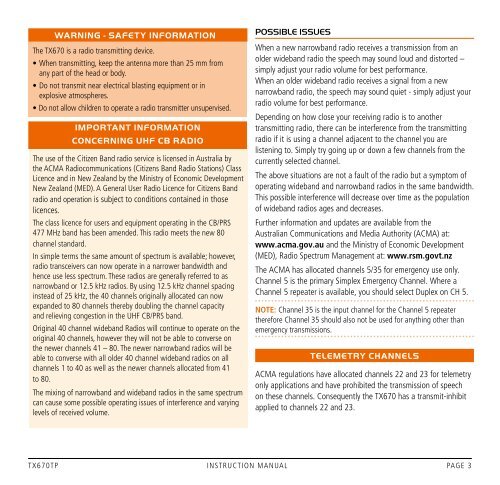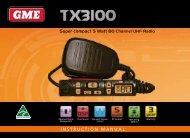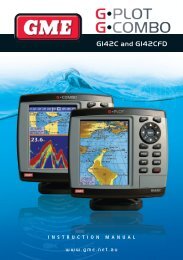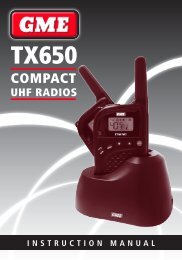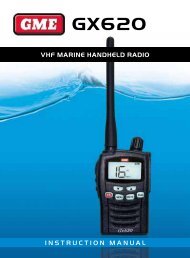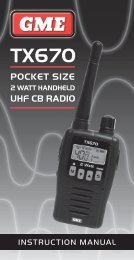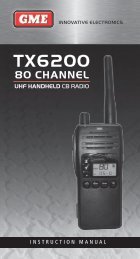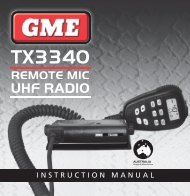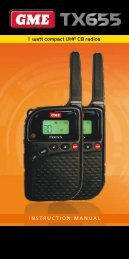2 watt handheld UHF CB radio INSTRUCTION MANUAL - GME
2 watt handheld UHF CB radio INSTRUCTION MANUAL - GME
2 watt handheld UHF CB radio INSTRUCTION MANUAL - GME
- No tags were found...
You also want an ePaper? Increase the reach of your titles
YUMPU automatically turns print PDFs into web optimized ePapers that Google loves.
WARNING - SAFETY INFORMATIONThe TX670 is a <strong>radio</strong> transmitting device.• When transmitting, keep the antenna more than 25 mm fromany part of the head or body.• Do not transmit near electrical blasting equipment or inexplosive atmospheres.• Do not allow children to operate a <strong>radio</strong> transmitter unsupervised.IMPORTANT INFORMATIONCONCERNING <strong>UHF</strong> <strong>CB</strong> RADIOThe use of the Citizen Band <strong>radio</strong> service is licensed in Australia bythe ACMA Radiocommunications (Citizens Band Radio Stations) ClassLicence and in New Zealand by the Ministry of Economic DevelopmentNew Zealand (MED). A General User Radio Licence for Citizens Band<strong>radio</strong> and operation is subject to conditions contained in thoselicences.The class licence for users and equipment operating in the <strong>CB</strong>/PRS477 MHz band has been amended. This <strong>radio</strong> meets the new 80channel standard.In simple terms the same amount of spectrum is available; however,<strong>radio</strong> transceivers can now operate in a narrower bandwidth andhence use less spectrum. These <strong>radio</strong>s are generally referred to asnarrowband or 12.5 kHz <strong>radio</strong>s. By using 12.5 kHz channel spacinginstead of 25 kHz, the 40 channels originally allocated can nowexpanded to 80 channels thereby doubling the channel capacityand relieving congestion in the <strong>UHF</strong> <strong>CB</strong>/PRS band. Original 40 channel wideband Radios will continue to operate on theoriginal 40 channels, however they will not be able to converse onthe newer channels 41 – 80. The newer narrowband <strong>radio</strong>s will beable to converse with all older 40 channel wideband <strong>radio</strong>s on allchannels 1 to 40 as well as the newer channels allocated from 41to 80. The mixing of narrowband and wideband <strong>radio</strong>s in the same spectrumcan cause some possible operating issues of interference and varyinglevels of received volume.Possible issuesWhen a new narrowband <strong>radio</strong> receives a transmission from anolder wideband <strong>radio</strong> the speech may sound loud and distorted –simply adjust your <strong>radio</strong> volume for best performance.When an older wideband <strong>radio</strong> receives a signal from a newnarrowband <strong>radio</strong>, the speech may sound quiet - simply adjust your<strong>radio</strong> volume for best performance.Depending on how close your receiving <strong>radio</strong> is to anothertransmitting <strong>radio</strong>, there can be interference from the transmitting<strong>radio</strong> if it is using a channel adjacent to the channel you arelistening to. Simply try going up or down a few channels from thecurrently selected channel.The above situations are not a fault of the <strong>radio</strong> but a symptom ofoperating wideband and narrowband <strong>radio</strong>s in the same bandwidth.This possible interference will decrease over time as the populationof wideband <strong>radio</strong>s ages and decreases.Further information and updates are available from theAustralian Communications and Media Authority (ACMA) at:www.acma.gov.au and the Ministry of Economic Development(MED), Radio Spectrum Management at: www.rsm.govt.nzThe ACMA has allocated channels 5/35 for emergency use only.Channel 5 is the primary Simplex Emergency Channel. Where aChannel 5 repeater is available, you should select Duplex on CH 5.NOTE: Channel 35 is the input channel for the Channel 5 repeatertherefore Channel 35 should also not be used for anything other thanemergency transmissions.Telemetry ChannelsACMA regulations have allocated channels 22 and 23 for telemetryonly applications and have prohibited the transmission of speechon these channels. Consequently the TX670 has a transmit-inhibitapplied to channels 22 and 23.TX670TP <strong>INSTRUCTION</strong> <strong>MANUAL</strong> PAGE 3


